NAAR … a name that has reverentially been on the tip of every gourmet tongue since its baptism into the vast culinary landscape of India, which I can safely say, having only recently enjoyed a first of what I hope will be several encounters, is much deserved.





Clockwise from top left:
Entrance to the main dining room of NAAR,
one of the 15 courses served,
Chef Prateek sadhu at work
There is already a plethora of articles available online, each one more enticing than the next, rife with detailed practical information and startlingly evocative descriptions of the premises, chef, his culinary background, inspiration and objectives, yet I cannot help but jump onto the bandwagon, for I believe that an experience of NAAR, especially during its adolescence, must not be left undocumented.
Moreover, since I have the benefit of the efforts made by my various predecessors, I am going to leapfrog straight into telling the tale of my own experience, which I will begin by stating, with complete confidence, that Prateek Sadhu is in a league of his own in India, but perhaps not for the most obvious reasons.




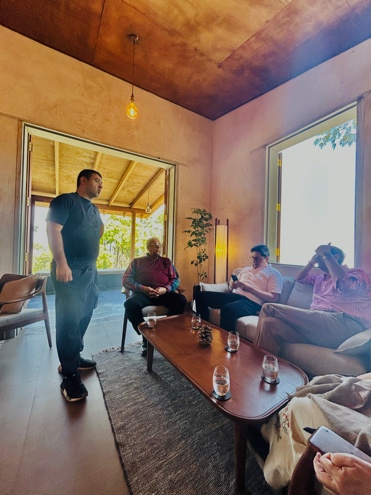
Above: Images of and from the salon of NAAR,
in which one is served a pre-meal drink and hors d’oeuvres
I suspect what might be the least apparent to many diners, is his profound understanding, love and mastery of the cooking techniques synonymous with contemporary European ‘Haute Cuisine’, aka fine dining, his menu far more of a duet of Indian and European flavors and textures, rather than a marriage of the two, the compatibility of the latter, like many a marriage, not only less harmonious but also not quite as enduring.
What is both remarkable & courageous, but may prove to be unsustainable, is the chef’s self-imposed handicap with respect to the use of ingredients sourced uniquely from India’s Himalayan belt, comprising the states of Ladakh, Himachal Pradesh, Uttarakhand, Sikkim, Kashmir and Arunachal Pradesh; in fact, the winter menu being served the day I went included a breast of duck sourced from New Delhi rather than Kashmir, the latter a state in which the bird is no stranger to the local cuisine, but such a minor discrepancy must be forthwith forgiven if not altogether overlooked.
The second reason for which I find Prateek Sadhu beyond compare, is his unequivocal dedication to gastronomy that is demonstrated by the location of the restaurant, for it both commands and guarantees a ‘natural selection’ of diners equally committed to the culinary experience…after all, no matter how lucrative for the balance sheet it may be, NAAR certainly doesn’t summon a noisy, drunken night out in which the food is but incidental; indeed Sadhu has had the courage to not hedge his bets, and without much further ado, on to the heart of the matter I go.
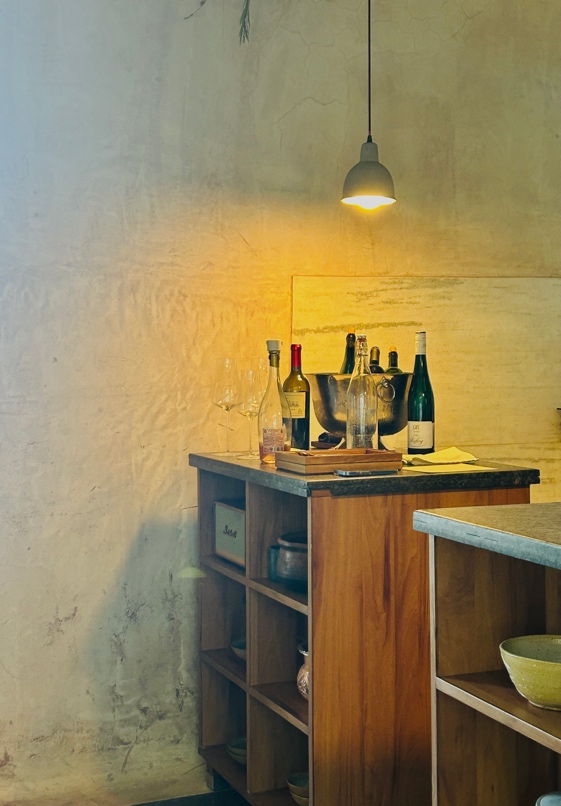
Above: The drinks serving station in the main dining room
The chef and his team do not like to be asked questions about what one is eating, (as you might have guessed, there is no written menu on offer, only a spoken one and that too, with emphasis placed on an economy of vocabulary) or at least not by a common diner as opposed to journalist; I was told in no uncertain terms to simply enjoy the journey and keep my curiosity at bay, hence my descriptions are somewhat incomplete, and I can only hope the photographs, however amateur, will compensate.…alas, in spite of being a trained chef myself, Sadhu’s is not an easily discernible and dissectible ‘brand’ of cuisine, but he and his team are of course perfectly justified, for the real essence of romance lies in an unsolvable mystery.
What came as a terrific surprise, and to me personally something of a novelty, is how Sadhu throws a punch as soon as the whistle blows, beginning his menu with the most strident and robust flavours and textures, gradually progressing to those that are a veritable exercise in tact and subtlety, with a few tremors in between.

Above: Barbeque Pork ‘Babru’
In the salon where one is received and offered an aperitif, there is a trio of amuse bouche served in perfectly timed succession, beginning with a spicy, sweet, chewy (with reference to the pastry) and crunchy bbq pork babru, a tribute to a recipe common to both Himachal Pradesh and Kashmir, comprising a stuffed ‘kachori’ like pastry that is both fried and baked, the sweet and spicy barbeque pork filling of questionable provenance, but nonetheless incontestably delicious.




Above: Stinging nettle leaf with cured lamb tartare,
& Below: Bubble potato with clotted cream and trout roe
Next up, a stinging nettle leaf canape, paper thin and consistently crisp as if either slow baked in the oven or air fried, in lieu of the patchy and temperamental tempura or pakora batter rendition, covered with a cured, lemony and piquant lamb tartare of unambiguous origin i.e. Ladakh, came as a moment of divine intervention on the palette, mollifying the element of chilli and providing a heavenly couplet of textures, the finely diced meat nothing short of velvety against its brittle base.
Finally, the last of the formidable triad, a bubble potato crisp with clotted cream and local trout eggs, the potato so irresistibly frangible and potential of flavour so great, I am forced to decry the nationalist or rather ‘localist’ sentiment in this particular case, for there really is no adequate substitute for both sour cream – even the local Indian one by brand Flanders would have been preferable – and imported trout roe; that said, the perfection of the potato saved the delicacy and in spite of its shortcomings, overall I was completely and utterly seduced by the foreplay and eagerly awaited the rest…needless to say, for I do believe the photographs do justice, the handsome, yet understated presentation of each dish was the absolute cherry on the icing on the cake.





Above: entrance and images of main dining room
We (my party of 5, including myself) were then chivalrously guided to the main dining room for the remaining 12 of NAAR’s 15 course serenade, beginning with what I would, in hindsight, call the first of two palate cleansers; fresh almond milk, whipped ricotta style almond pulp, tomatoes and a herb oil. There was another vegetable included which I was unable to identify, in addition to an equally mysterious reduction resembling a balsamic one…my tasting notes read as bitter-sweet / gazpacho meets ajo blanco, the latter the less well known chilled Spanish almond soup, and all I can add is that it was a most skilful and soothing ensemble on the palate, just as I imagine the Chef intended it to be in anticipation of the next dish, ‘Dirty Toast’, which in my opinion, was the veritable star of the show.
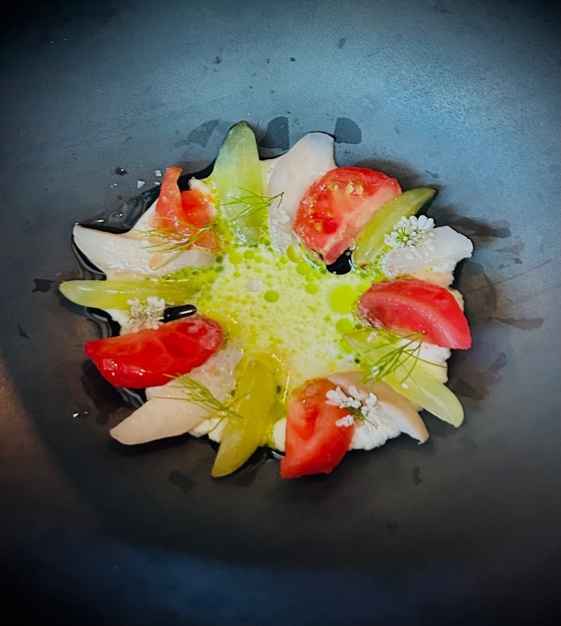
Above: Almond milk, with almond pulp ricotta,
tomatoes and herb oil
A thick cut of beautifully and lightly smoked, buttery local trout served atop a peppery mustard emulsion with hints of both English horseradish and Japanese wasabi, all held up by a rectangle of a Ladakh specialty bread that is a cross between a brioche and ciabatta…well what can I say but this deserves a place on the list of the most creative and delicious culinary compilations of 2023-24, and must be tasted to be believed.

Above: ‘Dirty Toast’
We certainly hadn’t had our fill of trout and could not have been more pleased when the next dish appeared, titled, ‘Barely cooked trout’, an equally succulent cut of fish, served with a roasted vegetable and yeast ‘cappuccino’, garnished with both crunchy raw peas and what tasted like a chili flake oil, but may well have been paprika, and frankly dominated the flavor of the dish, but without undermining the absolutely masterful cooking of the trout, (I must admit I was unable to divine whether it had been cooked sous-vide, steamed, oven poached, or briefly passed under a salamander) which left the deep interior a medium rare, the translucent flesh – a hall mark of fresh fish – with the taste and texture of a high-caliber sashimi.


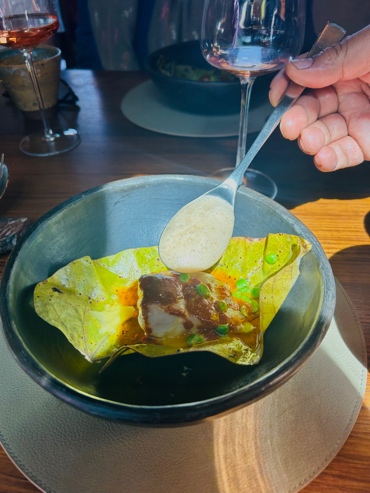


Clockwise from top left: The stages of the barely cooked trout until its eating
Next up was one of the little tremors I earlier mentioned, in the midst of the progressive subtlety that had even more subtly taken over, and that was – if I remember correctly – simply called ‘Carrot’, and without a shadow of a doubt, the silver medalist on the list of the most creative culinary compilations I have tasted in a long time, not to mention mouthwateringly delicious: a brunoise (i.e. tiny cubes) of poached carrots, combined with the most striking dried and smoked ones (which could easily have been mistaken, especially in texture, for sundried tomatoes) nestled in a cumin and coriander flavored carrot buttermilk, was entirely novel in conception, imperious in flavor and wonderfully mischievous in its medley of textures…in short, an absolute winner, which the chef was wise to follow up with a sturdy dish – ‘an hommage to Tibet’ he said – constituted by noodles, shredded lamb blood sausage and a full-bodied mutton broth; outspoken, confident, lip-smacking and a perfect display of culinary shabby-chic.

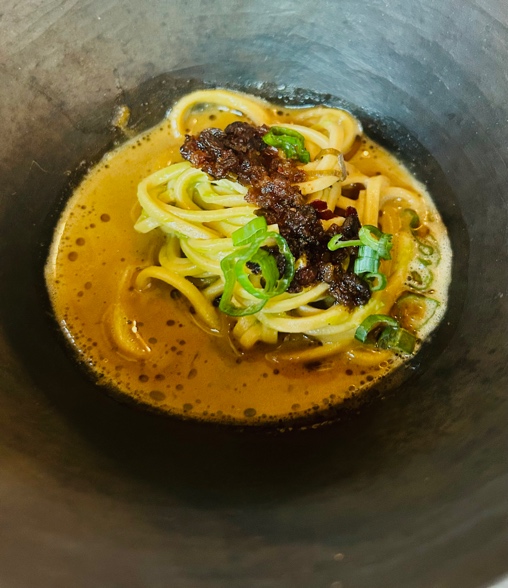
Above left: Carrot
Above right: Blood sausage, noodles, mutton broth
It was certainly time for a second palate cleanser, which came in the form of a lemon segment salad, dressed with a hemp seed chutney and crowned with a yoghurt foam…sweet, salty, tart, spicy, soft and prickly, there could not have been a better interval to, and preparation for the rest of the meal…

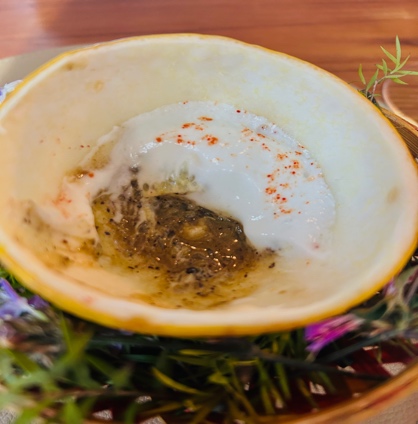
Above: Lemon segment salad, hemp chutney dressing, yoghurt foam
…starting with course number 11, which we were told was the first of two main courses, comprising three pieces of what appeared to be pork belly, possibly twice cooked and perfectly tender but perhaps a little de-hydrated, placed on a white sesame sauce that brought to mind the tahini one that unfailingly accompanies a shawarma, served with an array of chutneys including apple, hemp, mango, mustard and watercress (I cannot remember all of the names and my notes are incomplete) and a miniature version of the Chef’s take on the Mughlai Bakarkhani bread, served with whipped butter…suffice to say that this dish, whilst lean and well executed, was short on fat, flavor and charm…moreover the diminutive, schooled and embellished version of the Bakarkhani was certainly no chip off the old block…perhaps on its own, or as part of a small and relatively classic menu, the dish and its accoutrements would have been better received, but unfortunately it paled in comparison to the dishes it came after, as was the case with the next main course, a Himachal red rice ‘risotto’ with cured egg yolk, side of Kashmiri yakhni sauce, and pan to oven roasted breast of duck.

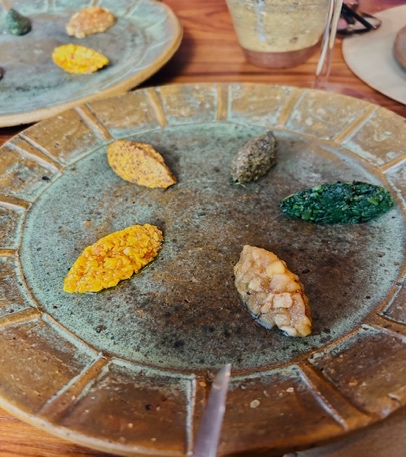


Clockwise from top left:
Pork on white sesame sauce,
platter of chutneys,
mini Bakarkhani bread,
whipped butter
While the duck was both superbly cooked and sliced, and the yakhni sauce delicious (I most unfortunately forgot to take a photo of the sauce) the rice with egg yolk was sloppy and thus the entire compilation was compromised…that very same duck breast, placed on a bed of saffron pulao, with the yakhni sauce poured on top would have been a far more fitting finale and certainly received a resounding applause…but then not even the most accomplished chef in the world can be expected to get each one of 15 courses perfectly right.





Above: Images of the Himachal red rice ‘risotto’ with cured egg yolk,
and the roast and sliced breast of duck
Of the remaining three courses, I shall write only briefly, for two main reasons: the first is that they don’t warrant a lengthy commentary, and second, I have already written quite enough by way of urging you to visit NAAR, both for your own pleasure and longevity of the restaurant.




Clockwise from top left:
strawberry sorbet,
millet and pineapple cake,
brown butter ice-cream,
petits-fours
The strawberry sorbet with a charred, spicy strawberry salad was somewhat limp, indicating that the kitchen was perhaps overplaying its hand, and both the dessert – a millet and pineapple cake served with brown butter ice-cream – and petits fours that followed unfortunately met the same fate i.e. a consensus of simply very ordinary…

Above: The Cheese board
…but the selection of cheese, sourced from the neighboring town of Mashobra where a Frenchman is locally reproducing some of his country’s finest varieties himself, was the most formidable final punctuation mark to an unequivocally staggering and unforgettable meal, one that gives plenty of reason to go back with each and every change of season for the new and exciting menu NAAR promises it will bring.
Round 2, November 2024





Clockwise from top left: Corner of Entrance to Main Dining Room, Glass of Sparkling Rose at Deck of Bar & lounge, Mathri Tartlets
Who could ever have guessed that in the space of a meagre 6 months, NAAR would further raise the bar, not just by a couple of inches, but a veritable mile … and that too, with executive chef-owner Prateek Sadhu behind neither stove nor smoker the day I went for lunch the second time, on November 26th 2024 … he was in fact in Paris, France, receiving yet another richly deserved award.
Without a shadow of a doubt, one for the culinary playbook, especially in India where this level of quality and consistency is rarely, if ever, achieved without the constant scrutiny and periodic intervention of the chief of a culinary team …

Above: Outdoor Deck of Bar & Lounge
… And that is perhaps where Prateek sadhu’s hidden genius lies i.e. in imparting his skills so surgically and thoroughly that he makes his own presence dispensable, and thus available for continuous culinary R & D.
Other than four of the fifteen courses, this was an entirely new menu for me, its most striking feature a showcasing of the bakery skills of the kitchen team, beginning with a mini beignet of smoked cheese, garnished with orange marmalade, melodiously titled ‘Askalu’ … the tapioca flour beignet, which upon first taste I mistook for a brioche, was a little bite of textural heaven, the orange marmalade a perfect supporting flavor for the smoked cheese, even though the parsimonious quantity of the latter rendered the taste a little faint; as much as I am a champion of the notion ‘less is more’, in this case I would suggest being a little more generous.
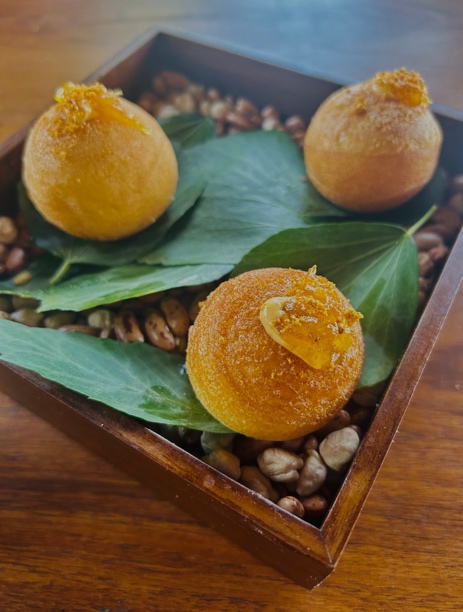
Above: ‘Askalu’… smoked Cheese beignets, orange marmalade
The next new hors d’oeuvre was the ‘mathri’ tartlet with a cherry and tomato chaat filling, veiled by sweetened yoghurt; in the spirit & technique of shortcrust pastry, this brilliantly executed buttery & crumbly gram flour & semolina tart with both scents and tastes of fenugreek & carom seeds, was both a lesson in the virtues of subtlety and most striking contrast to the fruity chaat within & sweetened yoghurt atop.
Then the final new hors d’oeuvre served at the bar was the ‘bagel’ style, flaxseed enriched ‘Sel Roti’ filled with pulled pork; a sophisticated and perfectly uniform version of the traditional Nepalese fried rice flour bread, with its crisp surface and pillowy interior, the case itself was sheer poetry on the palate, but alas altogether dominated the pulled pork filling, which requires a slightly more muscular seasoning to be able to hold its own …

Above: Sel roti, Pulled Pork
… But nonetheless a delicious note on which to move to the main dining room, where the Naar superstar small plate, ‘Dirty Toast’, immediately made an appearance by way of introduction to the rest of the culinary symphony …
… I, like many others who have had the good fortune of savoring this dish, dedicated a virtual eulogy to it the last time, hence will move onto the next winsome dish that was a perfectly executed trout ceviche, combined with monkey fruit and served in a delicate seabuckthorn broth, the balance of sweet, sour and spice so skillful, it brought a gasp of both surprise and delight to each one of my lunch companions upon first taste.


Above left to right: Main Dining Room, Trout Ceviche
And then, as if to further prove the exceptional talent of Sadhu and his culinary team, came a third rendition of trout, this one the most accomplished in terms of technique, and that was a fire roasted chorizo stuffed trout roll, shaped as a ‘steak’ and served in a vegetable and yeast cappuccino that was the most dexterous combination of the scents and tastes of both land and sea.
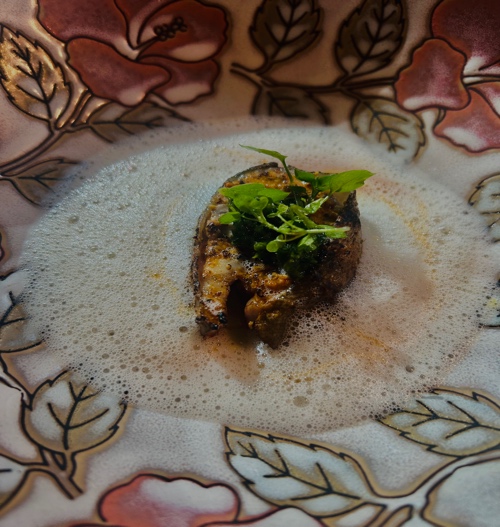
Above: Fire Roasted Trout & Chrorizo Roll
Next up, what they call ‘Lamb Bheja’, served on a corn roti, was a succulent, melt in the mouth, lamb brain ‘galouti’ style kebab, the roti a perfectly submissive chaperone to a strident taste that must be allowed to subjugate all the other flavors and textures that accompany it …

Above: Lamb Bheja
… Unlike the next nimble & powerful dish of Bansi wheat noodles garnished with a chunky lamb mince and nestled in a timru (aka prickly ash) broth that had the tones of a rasam and tenor of a laksa, albeit without coconut milk … in short, a simply sumptuous little dish in which each component is co-dependent, the final product one that makes the tastebuds gurgle with pleasure.

Above: Lamb Mince, Bansi Wheat Noodles, Timru Broth
It was now time for a palate cleanser that came in the form of a plum nectarine salad topped with a foam of the same fruit, which quite efficiently did the job, making way for the first of two main courses, and the only one that was somewhat disappointing: a horsegram stuffed parantha served with acidic butter, bhang chutney, and ‘confit’ style duck, was a surprisingly heavy handed assembly and vastly short on flavor, for which neither the acidic butter nor bhang chutney were compensation enough … I personally would recommend a crisp bread base, mildly sweet seasoning to the duck meat that allows for a slight char and caramelization during a second quick cook over fire …





Above: Images of Horsegram stuffed parantha, acidic butter, bhang chutney and duck … served ‘peking duck’ style
… That said, the disappointment was quickly forgotten upon the service of the next dish: a pressed and sliced pork rib that was so polished in technique and accomplished in degree of cooking, not only was the gustatory satisfaction inelegantly voluble, but also the applause at the table altogether resounding.
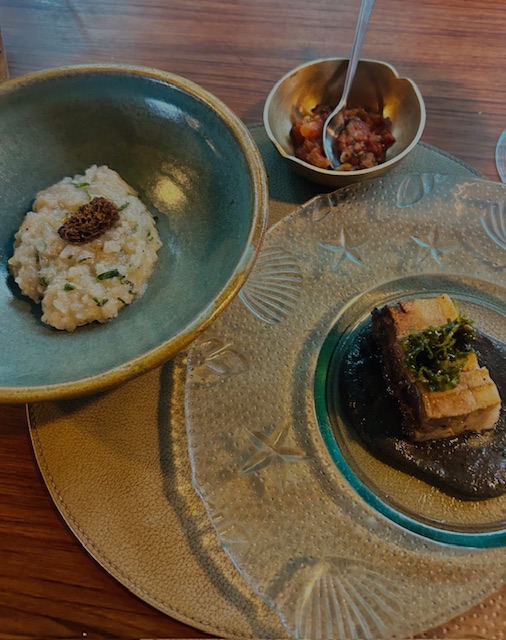
Above: Nagaland Pork Rib Meat, black sesame coulis, tomato & fermented soyabean chutney, rice ‘porridge’ with morel
And finally, the last of the new dishes was a luscious pre-dessert of a quenelle of salted green and red apple sorbet, followed by a repetition of the main dessert which on my last visit had been somewhat dry and therefore disenchanting, but this time made a formidable comeback; a warm and wonderfully moist ragi and pineapple cake served with a masterful brown butter ice cream that left me and my companions longing for an encore …
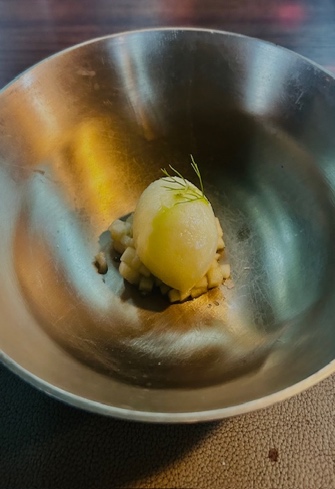


Above Left to Right: Apple Sorbet, Ragi & Pineapple Cake, With Brown Butter Ice-cream
… indeed I will be going back again … and I hope again, and again and again …
